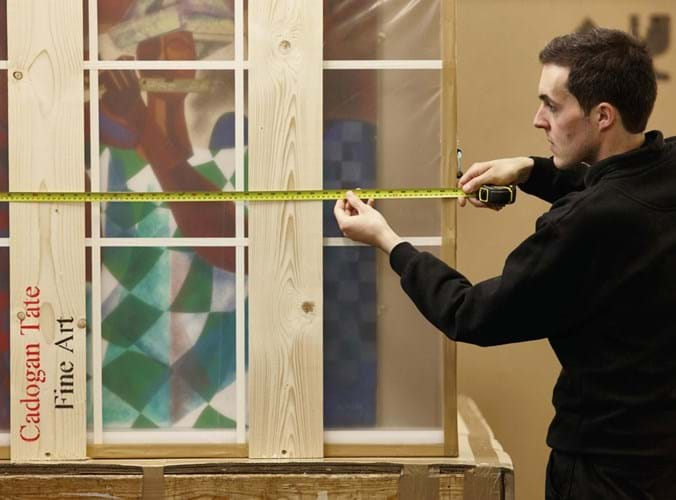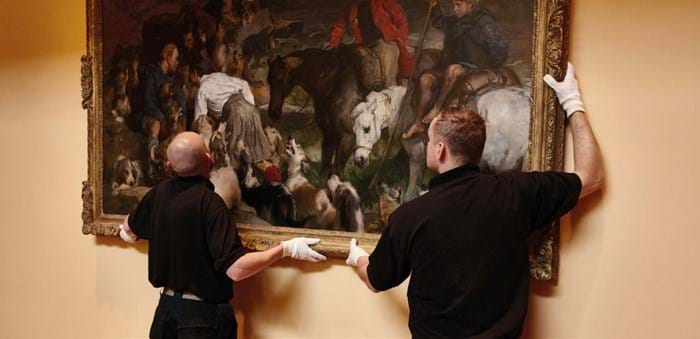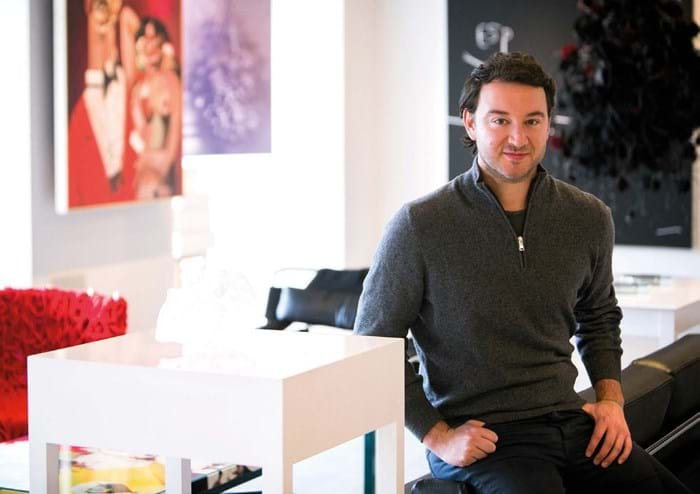
As early as the 1990s, with the arrival of eBay and the first generation of websites, the art and antiques market dreamt of a fully joined-up service – one where purchases could be made ‘at the click of a mouse from the comfort of your own home’.
In truth, with the technology in its infancy, internet speeds slow and logistical hurdles too high, the experience was anything but easy.
Only in the past decade, with the arrival of the smartphone and aggregator sites such as thesaleroom.com, has online purchasing gained real traction across the market.
Just one stumbling block remains. Cracking the so-called ‘final mile’ of packing and shipping is still the Holy Grail.
For some of us the trials and tribulations of moving a purchase from A to B are part of the experience of buying antiques – the opportunity to add another chapter to the life of an already storied object. It is precisely because these are not everyday items available via ‘click and collect’ that makes them special.
Rising expectations
However, Amazon and eBay, whose primary competitors are on the high street, have raised a generation of shoppers with expectations of cheap and speedy home delivery.
Many are asking: “Why can’t it be the same for ‘consumers’ of art and antiques?”
The short answer is that there is a world of difference between a household purchase and a professional service dealing with vulnerable and valuable works of art.
As Taner Ali, director of fine arts packing and shipping firm Brothers STS based in West Thurrock, Essex, puts it: “Every item is different. Many are fragile. This is not a production line. It will always be challenging.”
Duncan Hypher, business development manager at Mail Boxes Etc. (MBE) concurs. “This tends to be a bespoke service geared to the individual. Customers need an approach to packing, protecting and shipping which ensures [sometimes delicate objects] enjoy a safe passage through a high-volume, automated carrier network.”
The costs of safe passage have long been problematic in a very broad church like the antiques market. One size doesn’t fit all.
As Ali says: “It is much the same price to move a bench to Australia for a client whether he pays £200 for it at Newark or £20,000 at Masterpiece.”
Items priced at a few hundred pounds or less do incur relatively high charges. “The challenge is arriving at a proportionate shipping cost where fragile lots are sold at low hammer prices,” says Hypher. “The classic case is a large china tea set, where each piece has to be packaged separately if safe passage is to be guaranteed. We are still working on that.”

Issues of cost and logistics encountered by firms using the courier network apply equally to the higher end shippers responsible for end-to-end delivery. Photo courtesy of Cadogan Tate.
Managing consumer expectations when it comes to shipping and delivery of art and antiques may always be necessary.
Nonetheless, for those willing to shop around, choice is helping to bring pricing down. JenTel Packing, headquartered in Rayleigh, Essex, represents a little corner of the regional saleroom revolution – a business that came into its own with the arrival of live online bidding.
So too Bradleys Furniture Carriers, a removal firm in Darlington which now packs and collects on a weekly basis for Tennants.
Some salerooms are taking on the packing task themselves, not as a small revenue stream (typically the fees are passed onto the client at cost) but as a way of boosting the core business.
It also helps with space. As more items are bought by absentee buyers, auction storerooms are clogging up. The pressure to apply unpopular storage charges to uncollected items increases.
“The challenge is to arrive at proportionate shipping costs for low value items Duncan Hypher, Mail Boxes Etc.
Hansons in Derbyshire is among those auction houses with a recently-installed designated department for packing and shipping.
Charles Hanson considers it a necessity. “There is too much negativity around astronomical shipping charges. We are a service industry. We want the buyer to come back. We don’t want to lose them because of a bad aftercare experience.”
A stress-free shipping service makes for a loyal buyer, but other auctioneers believe this is a distraction they can do without.
After Sunday sales at Lots Road Auctions in Chelsea, customers are asked to have their items collected by Tuesday, or they will be charged storage. “You can’t provide all the services,” says Nick Carter, senior auctioneer and manager.
“Stick to what you do well and let the third-party specialists do what they do well. Location plays a part, but for us in London it is easy – we have an international courier 200 yards away. For London and the Home Counties we recommend Callaghan & Newbury to our customers for deliveries and it works incredibly smoothly.”
There are positive signs that the sector is increasingly ‘joined up’ in its thinking. With the imminent closure of its South Kensington rooms, Christie’s is expected to ramp up its online offering.
Several departments are already piloting a programme of internet-only sales formed around consignments from across its international hub. Pieces sourced in Paris, New York and London offices are photographed, catalogued and stored in the geographic locations to which they were consigned until a sale is made.
Orlando Rock, chairman of Christie’s UK, agrees that the cost and logistics of shipping were a major stumbling block in the online buying experience. It’s particularly important when the customer is a private buyer rather than a hard-bitten dealer.
“Selling an item online to someone who has never handled it requires first class service,” he says. “We have got better at it. But we need to get even better.”
Following a tie-up with Crown Fine Art, Christie’s clients are provided with an automatic shipping quote to wherever they are in the world. “It’s not an exclusive arrangement and some buyers will choose to use their own carrier while others will come to collect. However, it is helping to have the expertise of a specialist firm,” Rock says, adding that “we all aspire to the Amazon Prime model”.
A similar process is underway at the 160 shops that make up the MBE network.
“Technology has really changed the buying experience,” says Hypher. “Previously, after buying a lot online, a buyer would have to go offline and telephone to organise delivery. There was a gap. We now offer upfront shipping pricing online. The customer journey is much easier as it is an integrated experience with easy checkout to book delivery.” It is getting better.
Issues of cost and logistics encountered by firms using the courier network apply equally to the higher end shippers responsible for end-to-end delivery. Graham Enser, managing director of Fine Art at Cadogan Tate, says competition – and the changing nature of the customer base – is bringing down prices across the market at a time when freight costs are rising and the pound is weak.
“There are more shippers than ever before and the customer now has power to shop around
Graham Enser, Cadogan Tate
“There are more shippers than ever before and it is easier to get estimates from multiple companies quickly. The customer certainly has the power now – the power to shop around.”
It did not escape notice that last year shipping specialist Lockson left London to focus on the American market (the small team at Brothers STS were former employees).
The collapse of what was once called the shipping trade – the movement of large quantities of low to middle market merchandise from the UK to North America, Australia and Continental Europe – was the fundamental change.

Graham Enser, managing director of fine art at Cadogan Tate.
“Fifteen years ago we would ship 20 or more 40ft containers to the US a week. The dealers were driving the market then. Now we do perhaps one every fortnight,” says Enser.
Auction houses, high net worth individuals and decorators are now the area of growth, he continues. “We have expanded into the US and will focus on that market as currently the UK and Europe is stagnant. In the US interior designers are very powerful, and we do a lot of work with them.”
A price comparison site
This is doubtless the market that US technology firm Arta is hoping to tap as it expands into the UK and Europe.
Describing the sector as fragmented and lacking in transparency, the company has the aim of becoming a price comparison site for art logistics, ‘the Expedia of the art logistics world’.
Doubtless, Arta is right to believe there is room for improvement.
But it is perhaps a reminder how far online commerce has come since the 1990s that we all understand what that means.
The latest moves
“The logistics sector in the art and antiques world is a fragmented market. It was difficult to research, difficult to compare like-for-like quotes and there was a lack of transparency.”
Arta launches in UK
US technology firm Arta, a price comparison site for art logistics founded by Adam Fields in 2015, is expanding into the UK and Europe. Fields talks a good game: “We saw opportunities to make the search for a logistics company more efficient, making it better, faster and cheaper to find the best company for what you need.”
Crown Fine Art
Clients at Christie’s can now receive a “bought and delivered” price for forthcoming lots. Logistics firm Crown Fine Art is providing the service it claims can accurately estimate shipping costs before bids are placed.
Buyers in the the Europe, Middle East and Africa (EMEA) region can pay online for their purchases and shipping costs in a single transaction.
‘Everything could change’ with Brexit
Many who specialise in the movement of art and antiques are concerned about the advent of Brexit.
Concerns are that a return to the pre single-market era will slow down the movement of goods across international borders, will increase costs and paperwork, and require additional manpower. Many are hoping for the preservation of the customs union. But for now there are just questions.
“There is huge uncertainty around Brexit,” says Paul Williamson, director of fine art shipper Constantine. “Everything could change. Could Open Individual Export Licences (OIELs) be rescinded? We may have to hire more people but nobody knows what will happen yet.”
Duncan Hypher at Mail Boxes Etc concurs. “Our view is that it’s likely to mean more red tape, longer transit times and will probably be more expensive.”
















